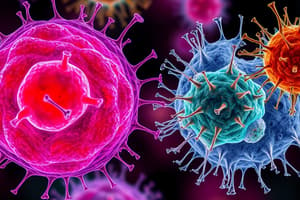Podcast
Questions and Answers
Which eukaryotic cell type is specialized for transmitting electrical signals through long extensions?
Which eukaryotic cell type is specialized for transmitting electrical signals through long extensions?
- Protozoan cells
- Algal cells
- Neurons (correct)
- Fungal cells
Which cell type features thicker myofibrils packed closely together, allowing for movement by contracting to generate force?
Which cell type features thicker myofibrils packed closely together, allowing for movement by contracting to generate force?
- Algal cells
- Plant cells
- Muscle cells (correct)
- Protozoan cells
Which cell type lacks a nucleus and is responsible for transporting oxygen throughout the body?
Which cell type lacks a nucleus and is responsible for transporting oxygen throughout the body?
- Red blood cells (correct)
- Neurons
- Animal cells
- Fungal cells
Which eukaryotic cell type is known for coordinating actions such as moving limbs by forming connections via synapses with neighboring neurons or muscles?
Which eukaryotic cell type is known for coordinating actions such as moving limbs by forming connections via synapses with neighboring neurons or muscles?
Among the five main eukaryotic cell groups, which one includes specialized types like muscle cells, neurons, and red blood cells?
Among the five main eukaryotic cell groups, which one includes specialized types like muscle cells, neurons, and red blood cells?
Which type of cell lacks membrane-bound nuclei and contains a single circular DNA molecule known as a plasmid?
Which type of cell lacks membrane-bound nuclei and contains a single circular DNA molecule known as a plasmid?
Which cell type houses a nucleus enclosed within a double membrane containing linear DNA strands?
Which cell type houses a nucleus enclosed within a double membrane containing linear DNA strands?
Which cellular structure is exclusive to plant cells among the options provided?
Which cellular structure is exclusive to plant cells among the options provided?
Which type of cell possesses cellular structures including mitochondria, endoplasmic reticulum, Golgi apparatus, and centrosomes?
Which type of cell possesses cellular structures including mitochondria, endoplasmic reticulum, Golgi apparatus, and centrosomes?
Archaea were previously thought to have similarities with bacteria but now belong to a separate domain of life due to differences in:
Archaea were previously thought to have similarities with bacteria but now belong to a separate domain of life due to differences in:
Study Notes
Diversity Within Life's Building Blocks: Understanding Cell Types
At their most fundamental level, all living organisms consist of cells—units where life occurs. Cells come in various shapes and sizes, each with unique roles and responsibilities, forming what we know as tissues, organs, and ultimately whole organisms. In this exploration, let's examine the different kinds of cells you might encounter while glancing under a microscope.
Cell types can generally be divided into two major categories based on their structure and function:
Prokaryotic Cells
These cells lack membrane-bound nuclei; instead, they contain a single circular DNA molecule called a plasmid in a region known as the nucleoid. Prokaryotes exist exclusively as either bacteria (Escherichia coli, commonly referred to as E.coli) or archaea. Archaea were previously thought to have some similarities with bacteria but now belong to a separate domain of life due to significant differences in genetics and biochemistry.
Eukaryotic Cells
Structurally more complex, these cells house a nucleus enclosed within a double membrane containing linear DNA strands. Compared to prokaryotic cells, eukaryotic cells possess several additional cellular structures, including mitochondria (the powerhouse of the cell), endoplasmic reticulum (where proteins are synthesized), Golgi apparatus (which processes and packages proteins), chloroplasts (found only in plant cells), and centrosomes (microtubule organizers). Eukaryotic cells fall into five main groups: animal, plant, fungal, protozoan, and algal cells.
Within these broader eukaryotic groupings, numerous specific cell types exist, many of which are specialized for particular functions. For example:
- Muscle cells, like skeletal muscle fibers, allow for movement by contracting to generate force. They feature thicker myofibrils packed closely together compared to other cell types.
- Neurons transmit electrical signals through long extensions (axons) to communicate between body parts over substantial distances. These cells may also form connections via synapses with neighboring neurons or muscles to coordinate actions such as moving limbs.
- Red blood cells transport oxygen throughout our bodies without a nucleus so that space isn’t wasted on nonessential activities. Instead, hemoglobin molecules absorb oxygen from air in our lungs and release it at tissue sites needing nourishment.
In summary, while cells vary significantly in terms of appearance, complexity, and role, their common purpose is to carry out essential biological functions and enable multitudes of species and organisms to thrive across the globe. Understanding diverse cell types provides valuable insights into the intricate workings of life itself.
Studying That Suits You
Use AI to generate personalized quizzes and flashcards to suit your learning preferences.
Description
Dive into the fascinating world of cell biology by exploring the various types of cells that make up living organisms. From prokaryotic cells like bacteria and archaea to the more complex eukaryotic cells found in animals, plants, fungi, protozoa, and algae, discover the structures and functions that define these microscopic building blocks of life.




